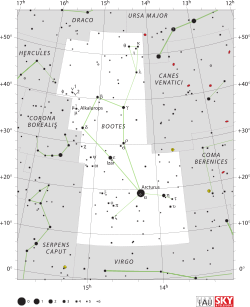الإزار (Epsilon Boötis) هو نجم مزدوج في كوكبة العواء. أسمه التقليدي Izar أوPulcherrima مشتق من الاسم العربي.
| الإزار | |
|---|---|
مكان الإزار «في الدائرة»
| |
| معلومات الرصد حقبة J2000 اعتدالان J2000 |
|
| كوكبة | العواء |
| مطلع مستقيم | [1] 14س 44د 59.21746ث |
| الميل | ° +27 ′04 ″27.2099[1] |
| القدر الظاهري (V) | 2.37[2] / 5.12[3] |
| الخصائص | |
| نوع الطيف | K0 II-III[4] + A2 V[5] |
| U−B مؤشر اللون | +0.73[2] |
| B−V مؤشر اللون | +0.97[2] |
| القياسات الفلكية | |
| السرعة الشعاعية (Rv) | -16.31[6] كم/ث |
| الحركة الخاصة (μ) | -50.95[1]+21.07[1] |
| التزيح (π) | 16.10 ± 0.66 د.ق |
| البعد | 203 ± 8 س.ض (62 ± 3 ف.ف) |
| تفاصيل | |
| A | |
| كتلة | 4.6[7] ك☉ |
| نصف قطر | 33[6] نق☉ |
| ضياء | 501[6] ض☉ |
| جاذبية سطحية (log g) | 2.2[6] سم.غ.ثا |
| درجة الحرارة | 4,550[6] ك |
| معدنية (فلك) | –0.13[6] |
| سرعة الدوران (v sin i) | 10.9[6] كم/ثا |
| عمر | 37.4 ± 4.2[8] م.سنة |
| B | |
| سرعة الدوران (v sin i) | 123[9] كم/ثا |
| تسميات اخرى | |
| Eps Boo, Izar, Pulcherrima, Mirac, Mirak, Mirach, 36 Boo, BD +27 2417, هيباركوس 72105[10] A: HD 129989, HR 5506, SAO 83500.[11] B: HD 129988, HR 5505.[3] |
|
يتكون من نجم عملاق ساطع ونجم نسق أساسي. النجم العملاق هو في مرحلة متأخرة نوعا ما من حياته حسب تطور النجوم، بعد أن استنفدت بالفعل امداداه من وقود الهيدروجين. بمرور الوقت نجم النسق الأساسي سيصل إلى هذه المرحلة من حياته وسيفقد النجم الأكبر الكثير من كتلته في سديم كوكبي، وسوف يتطور إلى قزم أبيض، وهكذا سيتغير دور هذين النجمين ليصبح النجم الكبير قزم معتم والصغير سيتحول إلى نجم عملاق.
تبلغ درجة حرارة النجم الأكبر 8700 كلفن والأصغر 4800 كلفن والقدر الظاهري 2,7 للأكبر و5,12 للأصغر.
مراجع
- van Leeuwen, F. (November 2007). "Validation of the new Hipparcos reduction". Astronomy and Astrophysics. 474 (2): 653–664. arXiv:. Bibcode:2007A&A...474..653V. doi:10.1051/0004-6361:20078357.
- Johnson, H. L.; et al. (1966). "UBVRIJKL photometry of the bright stars". Communications of the Lunar and Planetary Laboratory. 4 (99). Bibcode:1966CoLPL...4...99J.
- "HR 5506 -- Star in double system", SIMBAD, Centre de Données astronomiques de Strasbourg, مؤرشف من الأصل في 14 أبريل 2016,09 يناير 2012
- Luck, R. Earle; Wepfer, Gordon G. (November 1995), "Chemical Abundances for F and G Luminosity Class II Stars", Astronomical Journal, 110: 2425, Bibcode:1995AJ....110.2425L, doi:10.1086/117702
- Cowley, A.; et al. (April 1969), "A study of the bright A stars. I. A catalogue of spectral classifications", Astronomical Journal, 74: 375–406, Bibcode:1969AJ.....74..375C, doi:10.1086/110819
- Massarotti, Alessandro; et al. (January 2008), "Rotational and Radial Velocities for a Sample of 761 Hipparcos Giants and the Role of Binarity", The Astronomical Journal, 135 (1): 209–231, Bibcode:2008AJ....135..209M, doi:10.1088/0004-6256/135/1/209
- Gondoin, P. (December 1999), "Evolution of X-ray activity and rotation on G-K giants", Astronomy and Astrophysics, 352: 217–227, Bibcode:1999A&A...352..217G
- Tetzlaff, N.; Neuhäuser, R.; Hohle, M. M. (January 2011), "A catalogue of young runaway Hipparcos stars within 3 kpc from the Sun", Monthly Notices of the Royal Astronomical Society, 410 (1): 190–200, arXiv:, Bibcode:2011MNRAS.410..190T, doi:10.1111/j.1365-2966.2010.17434.x
- Royer, F.; et al. (October 2002), "Rotational velocities of A-type stars in the northern hemisphere. II. Measurement of v sin i", Astronomy and Astrophysics, 393: 897–911, arXiv:, Bibcode:2002A&A...393..897R, doi:10.1051/0004-6361:20020943
- "CCDM J14449+2704AB", SIMBAD, Centre de Données astronomiques de Strasbourg, مؤرشف من الأصل في 11 ديسمبر 2019,09 يناير 2012
- "HR 5505 -- Star in double system", SIMBAD, Centre de Données astronomiques de Strasbourg, مؤرشف من الأصل في 14 أبريل 2016,09 يناير 2012


